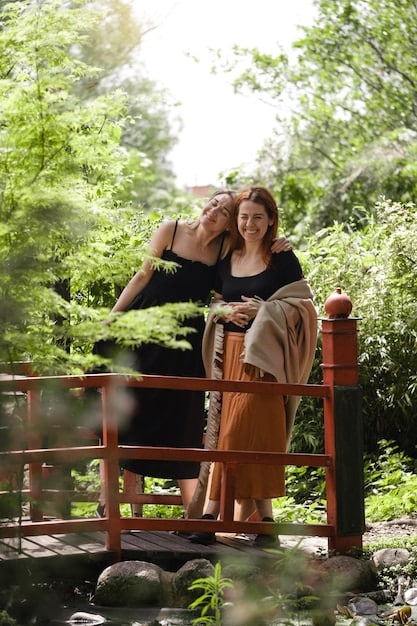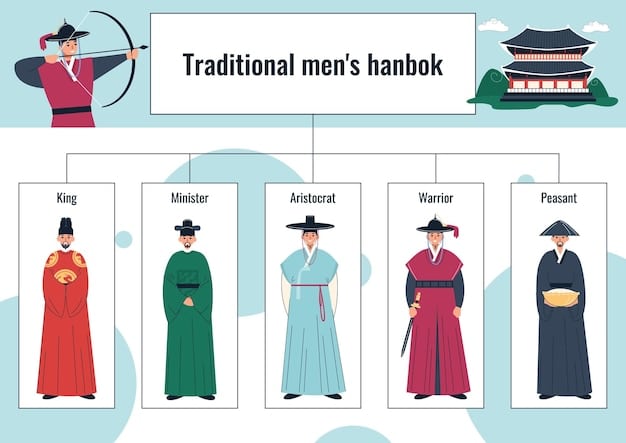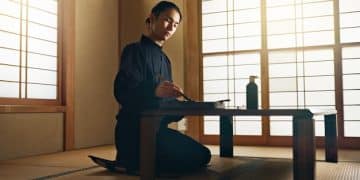Japanese Bowing Etiquette: A Guide for US Visitors

Mastering Japanese bowing etiquette is essential for US visitors, as it conveys respect and understanding of cultural nuances, facilitating smoother interactions in various social and professional settings.
For US visitors to Japan, understanding the nuances of Japanese bowing etiquette is far more than just a polite gesture; it’s a fundamental aspect of communication and respect. This intricate non-verbal language, deeply embedded in Japanese culture, signifies sincerity, gratitude, apology, or greeting, and mastering its subtle variations can significantly enhance your experience and interactions. Embracing this practice demonstrates a genuine effort to connect with the local customs, fostering mutual understanding and respect.
the historical and cultural roots of bowing in japan
The act of bowing, or “ojigi” (お辞儀), profoundly symbolizes many facets of Japanese society, from hierarchical structures to profound respect and humility. Its origins are deeply intertwined with Japan’s historical and spiritual landscape. Early records suggest that bowing predates recorded history, evolving from a simple gesture of submission to a complex system of social interaction. This evolution was heavily influenced by the introduction of Buddhism, which emphasized humility and the lowering of oneself before deities and elders.
During the feudal eras, particularly the Kamakura and Edo periods, bowing became formalized within the samurai class. The deeper the bow, the greater the respect or apology conveyed. This era cemented the importance of ojigi not just as a greeting but as a ritualistic display of one’s social standing and deference to others. It was a visible manifestation of the intricate social hierarchy that governed everyday life, with specific bowing angles and durations dictating the power dynamics between individuals. This formalization ensured social order and predictability in interactions, even among individuals of vastly different statuses. The nuance of a bow could mean the difference between honor and offense.
Today, while the strictness of feudal protocols has softened, the underlying principles of respect, humility, and hierarchy remain. Bowing is integrated into nearly every aspect of Japanese daily life, from business negotiations to casual encounters. The silent language of the bow communicates deference, gratitude, apology, and even sorrow, often conveying more than words ever could. For foreign visitors, appreciating these historical and cultural roots deepens the understanding of why bowing is not merely a formality but a deeply meaningful expression of Japanese identity and social harmony. It bridges gaps that language barriers might otherwise create, showing a willingness to engage with and respect a rich cultural heritage.
deciphering the types of bows: from greeting to deep reverence
Navigating the various types of bows in Japan can initially seem daunting, but understanding their context and meaning simplifies the process. Each bow, characterized by its angle and duration, communicates a specific message, ranging from casual greetings to profound apologies or expressions of gratitude. Deciphering these subtleties is key for seamless social interactions.
casual bows (eshaku)
Eshaku is the least formal bow, typically used for casual greetings among equals or when passing by someone you know. It involves a slight nod of the head or a bow of about 15 degrees from the waist. This bow is often exchanged quickly and can be accompanied by a verbal greeting. It signifies a polite acknowledgment without implying a strong social obligation.
formal bows (keirei)
Keirei is a more formal bow, performed with a deeper angle of about 30 degrees. It is commonly used in professional settings, when greeting customers, or when showing general respect to elders or superiors. The duration of this bow is slightly longer than eshaku, conveying more sincerity and deference. This bow is crucial in business environments, signaling respect and seriousness.
* Business Meetings: Use keirei when meeting new clients or supervisors.
* Entering or Exiting Shops: A quick keirei is common when staff acknowledge your presence.
* Thanking Service Staff: Show appreciation with a respectful keirei.
most humble bows (saikeirei)
Saikeirei, the most respectful and humble bow, is reserved for occasions of significant importance. This deep bow involves bending approximately 45-70 degrees from the waist, with the gaze directed downwards towards one’s feet. It is used to express profound apology, intense gratitude, or deep reverence towards someone of very high status. The duration of a saikeirei is also considerably longer, sometimes lasting several seconds.
* Profound Apologies: For serious mistakes or offenses.
* Expressing Deep Gratitude: For significant favors or kindness.
* Shrines and Temples: Showing reverence to deities or ancestors.
Understanding these distinctions allows visitors to respond appropriately in various social situations, showing not only politeness but also an informed appreciation for Japanese culture. The precise execution of each bow, though seemingly minor, speaks volumes about one’s character and intent.
practical guidelines for us visitors: when and how to bow
For US visitors, applying Japanese bowing etiquette involves understanding both the “when” and the “how.” While it’s unrealistic to expect perfection, making a genuine effort is highly appreciated. Remember, the Japanese value sincerity and effort more than flawless execution from foreigners.
when to bow
Bowing is a versatile gesture used in numerous situations.
It is typically performed when:
* Greeting someone for the first time or meeting an acquaintance.
* Thanking someone for a service or gift.
* Apologizing for an inconvenience or mistake.
* Leaving a farewell or saying goodbye.
* Entering or exiting a shop, restaurant, or home.
* During formal introductions or presentations.
Generally, if someone bows to you, it’s appropriate to bow back. The depth and duration of your return bow should ideally mirror the other person’s, showing reciprocal respect. However, don’t feel obligated to initiate bows in casual settings if you’re unsure; a polite nod and verbal “konnichiwa” (hello) or “arigato gozaimasu” (thank you very much) are often sufficient. It’s better to under-bow slightly than to over-bow inappropriately.
how to bow: step-by-step
The mechanics of bowing are simple yet crucial for conveying the correct message.
* Posture: Stand upright with your feet together. Men typically place their hands at their sides, while women often place them in front, interlocking their fingers.
* Eyes: Avoid making eye contact during the bow. It’s a sign of respect to lower your gaze.
* Movement: Bend from the waist, keeping your back straight and your neck aligned with your spine. The depth of the bend depends on the type of bow.
* Duration: Hold the bow for a moment, then slowly return to an upright position. The longer the hold, the more respect or sincerity is conveyed.
* Timing: Bows are usually performed before or after speaking, not during. Avoid bowing while walking; stop, bow, and then proceed.

A common mistake foreigners make is bowing too quickly or too deeply in casual situations, which can appear odd or insincere. Observe locals and try to emulate their actions, but don’t stress over perfection. Your genuine effort will be seen and appreciated. It’s a continuous learning process, and each interaction offers a chance to refine your understanding.
common mistakes to avoid and cultural sensitivities
While Japanese people are generally forgiving of foreigners’ misunderstandings regarding their intricate social customs, being aware of common bowing mistakes can help visitors navigate interactions more smoothly and show greater respect. These errors often stem from a lack of understanding about the underlying cultural values that bowing represents.
avoiding eye contact during a bow
A significant mistake is maintaining eye contact while bowing. In many Western cultures, direct eye contact signifies honesty and respect. However, in Japan, lowering your gaze during a bow is crucial. It demonstrates humility and deference, particularly to those of higher status. Gazing into someone’s eyes while bowing can be interpreted as a challenge or an assertion of equality, which is inappropriate in formal bowing situations.
not mirroring the bow appropriately
When someone bows to you, it is polite to return the bow. The common mistake is to return a much shallower or deeper bow than the one received. While it is not expected for foreigners to perfectly mirror the precise angle, a noticeable effort to match the level of formality indicates that you understand the reciprocal nature of the gesture. For instance, if a hotel staff member gives you a quick eshaku, a slight nod of your head is sufficient. If a business associate gives a keirei, a more pronounced bow on your part is appropriate.
bowing too casually or deeply
Another trap is using the wrong type of bow for the situation. A deep, long saikeirei for a casual greeting can seem overly dramatic or even sarcastic. Conversely, a brief nod when a deep bow is expected (e.g., apologizing for a significant mistake) can come across as dismissive or disrespectful. Understanding the context—whether it’s a casual interaction, a business meeting, or a moment of deep gratitude or apology—is vital. When in doubt, a mid-level keirei is often a safe, respectful choice for most general situations.
bowing while talking or walking
The act of bowing is a defined, distinct gesture. Bowing while speaking or while still in motion, such as walking, can diminish its significance. It is best to pause, complete your bow, and then resume speaking or moving. This intentional pause signifies the respect and focus given to the act itself, ensuring the sincerity of the gesture is fully conveyed. Taking a moment to fully perform the bow emphasizes its importance and your regard for the other person.
By being mindful of these cultural sensitivities and avoiding these common pitfalls, US visitors can better communicate their respect and appreciation for Japanese customs, making their interactions more meaningful and positive. The effort to learn and adapt, even imperfectly, is always noted and valued.
bowing in specific contexts: business, social, and personal
The application of bowing etiquette varies subtly across different contexts in Japan, signaling distinct intentions and relationships. Mastering these variations can significantly enhance a visitor’s ability to navigate Japanese society, from the boardroom to casual gatherings and personal interactions.
business settings
In the Japanese business world, bowing is a critical component of communication and hierarchy.
* Initial Introductions: When meeting new business partners or clients, a respectful keirei (30-degree bow) is standard. Business cards (meishi) are exchanged with both hands, accompanied by a slight bow. It is customary to receive a card with both hands and examine it carefully before placing it in a cardholder or on the table in front of you during a meeting.
* Negotiations and Meetings: Bows are used to display respect for higher-ranking individuals, to acknowledge a point made, or to express gratitude for someone’s time. A deeper “saikeirei” (45-70 degrees) might be used when making a serious apology or expressing profound gratitude for a significant business opportunity.
* Leaving: A final keirei is common upon departing, thanking hosts for their hospitality or time. Consistency in bowing practices reflects professionalism and builds trust.
social gatherings
Social bowing tends to be more relaxed than in business settings but still holds significance.
* Greetings: Among friends or in casual social settings, a lighter eshaku (15-degree nod) is common. However, if you are meeting someone’s elder or superior, a more respectful keirei is advisable.
* Dining: A slight bow might express gratitude to a host for preparing a meal or to restaurant staff for their service. It’s not uncommon to see diners bowing to the chef at a sushi counter as a sign of appreciation for their skill.
* Parties: Entering a social gathering, a general slight bow to the group and individual deeper bows to those you are formally introduced to are appropriate. When leaving, a bow expressing gratitude to the host is expected.
personal interactions and daily life
In everyday personal interactions, bowing is pervasive and often intuitive.
* Shopping and Service: Staff in shops, restaurants, and hotels frequently bow to customers as a sign of welcome and appreciation. A simple nod or slight bow in return is sufficient and polite.
* Apologies and Thanks: For minor inconveniences or small acts of kindness, a quick but sincere bow accompanies “sumimasen” (excuse me/sorry) or “arigato gozaimasu” (thank you very much). For more significant apologies or profound thanks, the bow naturally deepens and lengthens.
* Visiting Homes: When invited to someone’s home, a slightly deeper bow upon arrival and departure, coupled with verbal expressions of gratitude, shows appropriate respect for the hospitality.
Understanding these contextual differences allows US visitors to adapt their bowing to the situation, demonstrating cultural awareness and enhancing their interactions with Japanese people, fostering deeper connections.
the evolution of bowing in modern japan and its global influence
Bowing in Japan, while steeped in ancient tradition, has undergone subtle evolutions in modern society, reflecting both the influence of globalization and the enduring strength of cultural identity. This evolution highlights a fascinating interplay between continuity and change, making the etiquette both accessible to foreigners and deeply meaningful to locals.
modern adaptations in japan
In contemporary Japan, the strictness of bowing etiquette, while still prevalent in formal settings, has become slightly more flexible in casual public spaces. Young people, for example, might opt for a quick nod or a slightly shallower bow with friends or in very informal situations, compared to the more rigid adherence seen in older generations or professional environments. The advent of digital communication has also reduced the frequency of in-person bows for brief exchanges, yet the underlying principles of respect and humility remain paramount.
The rise of hybrid greetings, where a bow might be combined with a handshake, particularly when interacting with foreigners, is another sign of adaptation. This conciliatory gesture acknowledges global customs while maintaining a connection to Japanese tradition. However, it is crucial for foreign visitors to understand that while a handshake might be offered by a Japanese counterpart, especially in business, it is almost always followed—or preceded—by a bow, reinforcing that the bow is the primary form of greeting and respect. This blend reflects a desire for international inclusiveness without sacrificing core cultural practices.
global influence and perceptions
As Japan’s global presence has expanded through culture, technology, and tourism, its bowing etiquette has garnered international attention. Many foreign business professionals and diplomats now actively learn bowing customs, recognizing them as an indispensable part of effective engagement with Japanese counterparts. This indicates a broader understanding that true cultural fluency goes beyond language to embrace non-verbal communication.
However, global perceptions of bowing can sometimes be oversimplified, leading to stereotypes. Some may mistakenly view it as a sign of subservience rather than a complex expression of respect, humility, gratitude, or apology, depending on the context. Educating others about these nuances is crucial to dispelling misconceptions and fostering a deeper appreciation for Japanese culture. The elegance and discipline inherent in Japanese bowing are increasingly recognized worldwide as a unique and beautiful aspect of cultural identity, inspiring respect and admiration. This global dialogue contributes to a rich exchange, where traditional practices find new meaning in an interconnected world.
embracing bowing: beyond etiquette to cultural immersion
For US visitors to Japan, embracing bowing etiquette transcends mere politeness; it becomes a powerful conduit for cultural immersion and a tangible expression of respect for a rich heritage. Moving beyond a superficial understanding to a genuine appreciation of this fundamental practice unlocks deeper, more meaningful interactions. It signifies a willingness to engage that extends far beyond tourist clichés.
a silent language of respect
Bowing acts as a silent language, communicating layers of meaning that words alone might struggle to convey. It is a nuanced dance of humility, gratitude, and acknowledgment. When a foreign visitor makes a sincere effort to bow, even imperfectly, it sends a clear message: “I respect your culture, and I am here to learn.” This gesture often opens doors, transforming transactional encounters into genuine human connections. It is observed by locals as a sign of a thoughtful visitor, setting one apart from those who might inadvertently appear insensitive to local customs. The very act of attempting to bow, regardless of its perfection, is a gesture of goodwill that is universally recognized and appreciated in Japan.
fostering deeper connections
The effort to learn and implement bowing etiquette can lead to profound and unexpected positive outcomes. Japanese people are often delighted and impressed when foreigners show a genuine interest in their customs. This can result in warmer greetings, more patient assistance from service staff, and potentially even invitations to engage in cultural experiences that might otherwise remain inaccessible. For instance, in a business setting, a well-placed and sincere bow can build a foundation of trust and respect, paving the way for more successful negotiations and long-term relationships. In social contexts, it can transform a brief encounter into a memorable shared moment, leaving a lasting positive impression.
Ultimately, mastering the nuances of Japanese bowing etiquette is not about rigid adherence to rules but about understanding the spirit behind the gesture—a spirit of harmony, respect, and community. It is an invitation to engage with Japan on a deeper level, transforming a simple trip into a truly immersive cultural experience. By embracing this practice, US visitors are not just observing Japanese culture; they are actively participating in it, bridging cultural divides one respectful bend at a time. The payoff is not just smooth social interactions but a richer, more profound understanding of Japan itself.
| Key Bow Type | Purpose & Degree |
|---|---|
| 👋 Eshaku | Casual greeting, slight nod (15 degrees). |
| bows Keirei | Formal respect, business, general courtesy (30 degrees). |
| 🙇 Saikeirei | Profound apology/gratitude, deep reverence (45-70 degrees). |
| 👀 Eye Contact | Avoid direct eye contact during bows; lower your gaze as a sign of humility. |
frequently asked questions about Japanese bowing
While it’s polite to return a bow, especially if someone bows to you, it’s not always strictly necessary in casual encounters. A polite nod or a verbal greeting like “arigato gozaimasu” is often sufficient, particularly from store clerks. Japanese people understand that foreigners may not be familiar with all nuances.
A bow for apology (often Saikeirei) is typically deeper (45-70 degrees) and held longer, conveying profound sincerity and humility for a mistake. A greeting bow (Eshaku or Keirei) is shallower (15-30 degrees) and quicker, signifying polite acknowledgment or respect in social or business settings.
Generally, you do not need to bow to children in Japan. A friendly smile or a verbal greeting is appropriate. Children are taught to bow to adults, but adults are not expected to bow in return to children, similar to how elders are shown respect and not the other way around.
You can, especially in international business settings, and sometimes a Japanese person may initiate a handshake. However, the bow often precedes or follows the handshake. It is generally safer to let the Japanese person initiate the handshake if they wish to combine it with a bow, ensuring you prioritize the bow.
Bowing much deeper than a Japanese person in a casual setting can appear overly formal or even sarcastic. It’s best to try and mirror the depth of their bow. If unsure, a moderate Keirei (30-degree bow) is a safe and respectful option for most general interactions, showing appropriate deference without overdoing it.
conclusion: mastering the art of the bow for a richer japan experience
The journey to understanding the nuances of Japanese bowing etiquette is a significant step towards a more profound and respectful engagement with Japanese culture. Far from being a mere formality, the bow is a vital element of communication, expressing a spectrum of emotions and social intentions. For US visitors, making a genuine effort to learn and apply these customs not only facilitates smoother interactions but also demonstrates a deep appreciation for Japan’s rich traditions. Embracing the art of the bow transforms a visit into an immersive experience, fostering connections that transcend language barriers and leaving a lasting positive impression.





